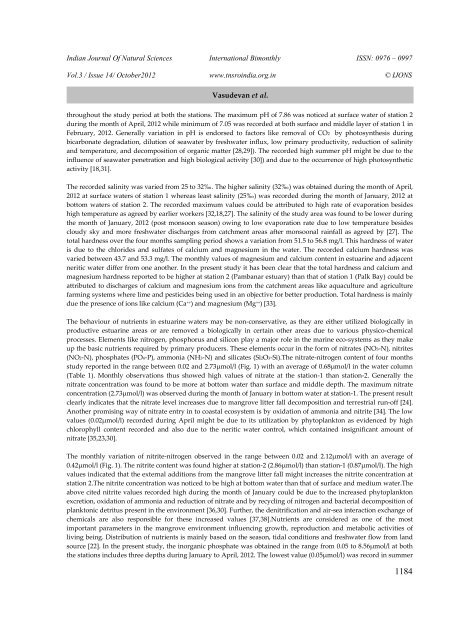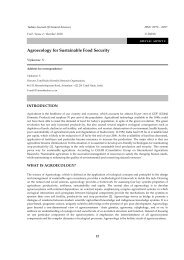Seismic Analysis of RC Frame Structure with and ... - tnsroindia.org.in
Seismic Analysis of RC Frame Structure with and ... - tnsroindia.org.in
Seismic Analysis of RC Frame Structure with and ... - tnsroindia.org.in
Create successful ePaper yourself
Turn your PDF publications into a flip-book with our unique Google optimized e-Paper software.
Indian Journal Of Natural Sciences International Bimonthly ISSN: 0976 – 0997<br />
Vol.3 / Issue 14/ October2012 www.<strong>tnsro<strong>in</strong>dia</strong>.<strong>org</strong>.<strong>in</strong> © IJONS<br />
Vasudevan et al.<br />
throughout the study period at both the stations. The maximum pH <strong>of</strong> 7.86 was noticed at surface water <strong>of</strong> station 2<br />
dur<strong>in</strong>g the month <strong>of</strong> April, 2012 while m<strong>in</strong>imum <strong>of</strong> 7.05 was recorded at both surface <strong>and</strong> middle layer <strong>of</strong> station 1 <strong>in</strong><br />
February, 2012. Generally variation <strong>in</strong> pH is endorsed to factors like removal <strong>of</strong> CO2 by photosynthesis dur<strong>in</strong>g<br />
bicarbonate degradation, dilution <strong>of</strong> seawater by freshwater <strong>in</strong>flux, low primary productivity, reduction <strong>of</strong> sal<strong>in</strong>ity<br />
<strong>and</strong> temperature, <strong>and</strong> decomposition <strong>of</strong> <strong>org</strong>anic matter [28,29]). The recorded high summer pH might be due to the<br />
<strong>in</strong>fluence <strong>of</strong> seawater penetration <strong>and</strong> high biological activity [30]) <strong>and</strong> due to the occurrence <strong>of</strong> high photosynthetic<br />
activity [18,31].<br />
The recorded sal<strong>in</strong>ity was varied from 25 to 32‰. The higher sal<strong>in</strong>ity (32‰) was obta<strong>in</strong>ed dur<strong>in</strong>g the month <strong>of</strong> April,<br />
2012 at surface waters <strong>of</strong> station 1 whereas least sal<strong>in</strong>ity (25‰) was recorded dur<strong>in</strong>g the month <strong>of</strong> January, 2012 at<br />
bottom waters <strong>of</strong> station 2. The recorded maximum values could be attributed to high rate <strong>of</strong> evaporation besides<br />
high temperature as agreed by earlier workers [32,18,27]. The sal<strong>in</strong>ity <strong>of</strong> the study area was found to be lower dur<strong>in</strong>g<br />
the month <strong>of</strong> January, 2012 (post monsoon season) ow<strong>in</strong>g to low evaporation rate due to low temperature besides<br />
cloudy sky <strong>and</strong> more freshwater discharges from catchment areas after monsoonal ra<strong>in</strong>fall as agreed by [27]. The<br />
total hardness over the four months sampl<strong>in</strong>g period shows a variation from 51.5 to 56.8 mg/l. This hardness <strong>of</strong> water<br />
is due to the chlorides <strong>and</strong> sulfates <strong>of</strong> calcium <strong>and</strong> magnesium <strong>in</strong> the water. The recorded calcium hardness was<br />
varied between 43.7 <strong>and</strong> 53.3 mg/l. The monthly values <strong>of</strong> magnesium <strong>and</strong> calcium content <strong>in</strong> estuar<strong>in</strong>e <strong>and</strong> adjacent<br />
neritic water differ from one another. In the present study it has been clear that the total hardness <strong>and</strong> calcium <strong>and</strong><br />
magnesium hardness reported to be higher at station 2 (Pambanar estuary) than that <strong>of</strong> station 1 (Palk Bay) could be<br />
attributed to discharges <strong>of</strong> calcium <strong>and</strong> magnesium ions from the catchment areas like aquaculture <strong>and</strong> agriculture<br />
farm<strong>in</strong>g systems where lime <strong>and</strong> pesticides be<strong>in</strong>g used <strong>in</strong> an objective for better production. Total hardness is ma<strong>in</strong>ly<br />
due the presence <strong>of</strong> ions like calcium (Ca ++ ) <strong>and</strong> magnesium (Mg ++ ) [33].<br />
The behaviour <strong>of</strong> nutrients <strong>in</strong> estuar<strong>in</strong>e waters may be non-conservative, as they are either utilized biologically <strong>in</strong><br />
productive estuar<strong>in</strong>e areas or are removed a biologically <strong>in</strong> certa<strong>in</strong> other areas due to various physico-chemical<br />
processes. Elements like nitrogen, phosphorus <strong>and</strong> silicon play a major role <strong>in</strong> the mar<strong>in</strong>e eco-systems as they make<br />
up the basic nutrients required by primary producers. These elements occur <strong>in</strong> the form <strong>of</strong> nitrates (NO3-N), nitrites<br />
(NO2-N), phosphates (PO4-P), ammonia (NH3-N) <strong>and</strong> silicates (Si2O3-Si).The nitrate-nitrogen content <strong>of</strong> four months<br />
study reported <strong>in</strong> the range between 0.02 <strong>and</strong> 2.73µmol/l (Fig. 1) <strong>with</strong> an average <strong>of</strong> 0.68µmol/l <strong>in</strong> the water column<br />
(Table 1). Monthly observations thus showed high values <strong>of</strong> nitrate at the station-1 than station-2. Generally the<br />
nitrate concentration was found to be more at bottom water than surface <strong>and</strong> middle depth. The maximum nitrate<br />
concentration (2.73µmol/l) was observed dur<strong>in</strong>g the month <strong>of</strong> January <strong>in</strong> bottom water at station-1. The present result<br />
clearly <strong>in</strong>dicates that the nitrate level <strong>in</strong>creases due to mangrove litter fall decomposition <strong>and</strong> terrestrial run-<strong>of</strong>f [24].<br />
Another promis<strong>in</strong>g way <strong>of</strong> nitrate entry <strong>in</strong> to coastal ecosystem is by oxidation <strong>of</strong> ammonia <strong>and</strong> nitrite [34]. The low<br />
values (0.02µmol/l) recorded dur<strong>in</strong>g April might be due to its utilization by phytoplankton as evidenced by high<br />
chlorophyll content recorded <strong>and</strong> also due to the neritic water control, which conta<strong>in</strong>ed <strong>in</strong>significant amount <strong>of</strong><br />
nitrate [35,23,30].<br />
The monthly variation <strong>of</strong> nitrite-nitrogen observed <strong>in</strong> the range between 0.02 <strong>and</strong> 2.12µmol/l <strong>with</strong> an average <strong>of</strong><br />
0.42µmol/l (Fig. 1). The nitrite content was found higher at station-2 (2.86µmol/l) than station-1 (0.87µmol/l). The high<br />
values <strong>in</strong>dicated that the external additions from the mangrove litter fall might <strong>in</strong>creases the nitrite concentration at<br />
station 2.The nitrite concentration was noticed to be high at bottom water than that <strong>of</strong> surface <strong>and</strong> medium water.The<br />
above cited nitrite values recorded high dur<strong>in</strong>g the month <strong>of</strong> January could be due to the <strong>in</strong>creased phytoplankton<br />
excretion, oxidation <strong>of</strong> ammonia <strong>and</strong> reduction <strong>of</strong> nitrate <strong>and</strong> by recycl<strong>in</strong>g <strong>of</strong> nitrogen <strong>and</strong> bacterial decomposition <strong>of</strong><br />
planktonic detritus present <strong>in</strong> the environment [36,30]. Further, the denitrification <strong>and</strong> air-sea <strong>in</strong>teraction exchange <strong>of</strong><br />
chemicals are also responsible for these <strong>in</strong>creased values [37,38].Nutrients are considered as one <strong>of</strong> the most<br />
important parameters <strong>in</strong> the mangrove environment <strong>in</strong>fluenc<strong>in</strong>g growth, reproduction <strong>and</strong> metabolic activities <strong>of</strong><br />
liv<strong>in</strong>g be<strong>in</strong>g. Distribution <strong>of</strong> nutrients is ma<strong>in</strong>ly based on the season, tidal conditions <strong>and</strong> freshwater flow from l<strong>and</strong><br />
source [22]. In the present study, the <strong>in</strong><strong>org</strong>anic phosphate was obta<strong>in</strong>ed <strong>in</strong> the range from 0.05 to 8.56µmol/l at both<br />
the stations <strong>in</strong>cludes three depths dur<strong>in</strong>g January to April, 2012. The lowest value (0.05µmol/l) was record <strong>in</strong> summer<br />
1184



